Evaluating The Financial Aspects Of Solar Energy Installment: Is It A Worthwhile Financial Investment?
Evaluating The Financial Aspects Of Solar Energy Installment: Is It A Worthwhile Financial Investment?
Blog Article
Write-Up By-McMillan Larsen
When considering the prices of solar installation, you could wonder about the ahead of time financial investment required and whether it straightens with the possible long-term benefits. Comprehending the ins and outs of these expenses and the numerous factors influencing the general return can clarify the value proposition of transitioning to solar energy. By assessing both the preliminary configuration prices and the forecasted savings over time, you can gain understanding right into whether the financial investment in solar installment holds pledge for your economic future.
First Setup Expenditures
When thinking about the prices of solar installment, the preliminary setup expenditures play an essential role in your decision-making procedure. These in advance costs consist of the rate of photovoltaic panels, inverters, mounting tools, and installment labor.
The cost of solar panels can vary depending on the brand, efficiency, and size you select. Inverters are necessary for converting the sun's energy into usable power and come in different types such as string inverters, microinverters, and power optimizers, each with its very own price implications.
Mounting devices, such as racks and rails, is necessary to securely install solar panels on your roof covering or home.
The setup labor cost covers the professional setup of the solar system, ensuring that everything is established correctly and successfully. Remember that while these preliminary configuration expenses may seem high, there are usually discounts, tax obligation rewards, and financing options available to aid offset the expenses and make solar setup a lot more inexpensive over time.
Long-Term Cost Savings Evaluation
To understand the economic benefits of solar installment gradually, it's critical to conduct a thorough long-lasting cost savings evaluation. While the initial setup expenditures of photovoltaic panels might appear overwhelming, the lasting financial savings can exceed these expenses significantly. By harnessing the power of the sun to generate power for your home, you can possibly conserve hundreds of bucks on your utility expenses over the lifespan of your solar system.
One of the essential elements to take into consideration in a long-term financial savings analysis is the reduction in your electrical energy expenses. With photovoltaic panels, you can create your electrical energy, lowering or perhaps eliminating your dependence on the grid. https://news.bloomberglaw.com/environment-and-energy/vulnerable-communities-poised-for-big-solar-gains-in-senate-bill can lead to significant cost savings, especially as energy prices remain to climb.
Additionally, https://40-watt-solar-panel21975.blogolenta.com/26750781/check-out-the-ways-in-which-solar-setup-can-boost-sustainability-increase-cost-savings-and-boost-the-value-of-your-property provide motivations such as tax obligation credit scores and refunds for mounting solar panels, even more boosting your long-term cost savings. By making use of these rewards and optimizing your solar energy manufacturing, you can enjoy substantial economic advantages for years to come.
Roi Estimation
Taking into consideration the monetary benefits of solar installment, it's time to analyze the Return on Investment (ROI) estimation. Figuring out the ROI entails comparing the overall prices of installing a solar system with the monetary advantages it produces over its life expectancy.
To compute ROI, divide the web benefit from the system by the total investment cost and multiply by 100 to obtain a portion. The ROI formula is: (Web Profit/ Total Amount Investment Cost) x 100.
For example, if the overall cost of installing a solar system is $20,000, and over its life expectancy, it generates cost savings and earnings totaling $30,000, the web revenue would certainly be $10,000. Dividing this by the total investment price of $20,000 offers a ratio of 0.5. Multiplying this by 100 gives an ROI of 50%.
Usually, a greater ROI shows an extra monetarily gratifying investment. Variables like government incentives, upkeep costs, and power cost variations can affect the ROI of solar installations. Comprehending the ROI assists in evaluating whether buying solar power is worth it in the long run.
Verdict
In conclusion, recognizing the costs of solar installment is vital for identifying if it deserves the investment. By considering first setup expenditures, conducting a lasting financial savings evaluation, and computing the roi, you can make an educated decision regarding the economic worth of solar energy. With the capacity for minimized energy expenses and boosted energy self-reliance, investing in solar setup can be a wise selection for both your wallet and the atmosphere.
